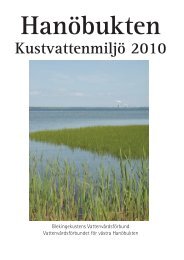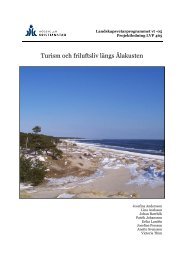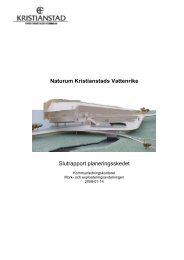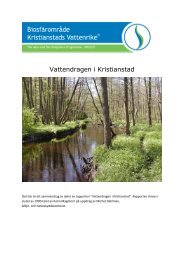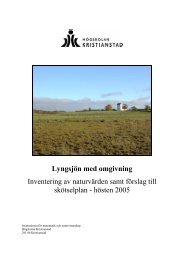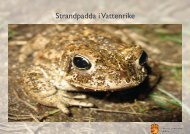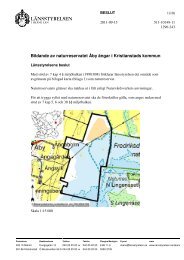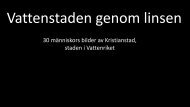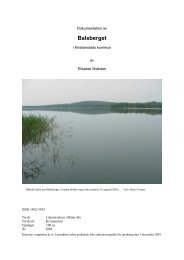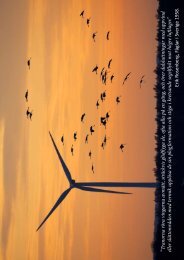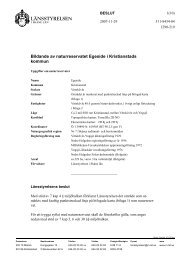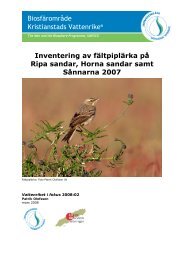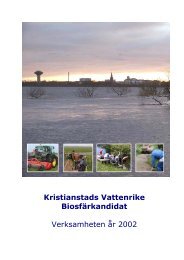Full version as pdf - Kristianstads Vattenrike
Full version as pdf - Kristianstads Vattenrike
Full version as pdf - Kristianstads Vattenrike
You also want an ePaper? Increase the reach of your titles
YUMPU automatically turns print PDFs into web optimized ePapers that Google loves.
Biosphere Reserve<br />
<strong>Kristianstads</strong> <strong>Vattenrike</strong> ®<br />
AV CE RT KI VS IA TMI HE S E T2 E0 N 0 9Å<br />
R 2 0 0 6<br />
<strong>Vattenrike</strong>t i fokus 2010:01 | Biosphere Office June 2010 | ISSN 1653-9338
2<br />
B I O S P H E R E R E S E RV E K R I S T I A N S TA D S VAT T E N R I K E | A C T I V I T I E S 2 0 0 9<br />
<strong>Kristianstads</strong> <strong>Vattenrike</strong><br />
Biospere Reserve<br />
Photo: Patrik Olofsson/N<br />
There are biosphere reserves all over the world.These<br />
protected are<strong>as</strong>, officially recognised by the UN agency<br />
UNESCO, demonstrate how to tackle thepractical<br />
challenges of combining nature conservation with<br />
development.<br />
<strong>Kristianstads</strong> <strong>Vattenrike</strong> Biosphere Reserve,<br />
established in 2005, includes the<br />
greater part of the Municipality of<br />
Kristianstad, from the forests to<br />
Hanöbukten Bay with the rich wetlands<br />
of the River Helge å and the town<br />
of Kristianstad at its heart.<br />
Extent: Greater part of the Municipality of<br />
Kristianstad.<br />
Area: 104,375 ha. Land and lakes, 90,515 ha;<br />
marine area, 13,860 ha.<br />
(Total land area of municipality: 134,620 ha.)<br />
Population: approx. 71,000 incl. approx.<br />
30,000 in the Kristianstad urban region.<br />
(Total population of municipality: 77,000)<br />
Species worthy of preservation: 20<br />
globally red-listed species, including corncrake<br />
and great raft spider, and some 60 EU listed species,<br />
including thick-shelled river mussel and sand pink (Dianthus<br />
arenarius). Around 700 nationally red-listed species in all, a<br />
high figure compared to other are<strong>as</strong> of Sweden.<br />
Approx. 30% of red-listed species in the province of Skåne<br />
occur in the biosphere reserve. The wetlands are home to<br />
120–130 regularly breeding species of bird. In all, some 260<br />
species have been recorded. At le<strong>as</strong>t 38 different species of<br />
fish have been caught in the inland waters: 32, including<br />
European catfish and loach, spawn in fresh<br />
water.<br />
Development projects: Local projects include<br />
biog<strong>as</strong> for municipal buses, wetlands<br />
ecotourism and the development of products<br />
from the wet gr<strong>as</strong>slands. Biological<br />
and recreational values are being developed<br />
hand in hand on one golf course in the<br />
sandy gr<strong>as</strong>slands.<br />
Zoning: The area’s status <strong>as</strong> a biosphere<br />
reserve h<strong>as</strong> not led to any new rules or<br />
directives. Zoning is a tool for prioritising and<br />
creating resources for working together with<br />
local residents, financial backers, etc. to avert<br />
threats and develop the natural values of the<br />
core are<strong>as</strong> and buffer zones.<br />
Thematic landscapes: Ten thematic landscapes<br />
with high natural values have been identified.<br />
Work will progress to all ten themes, but to date the main<br />
focus for conservation,<br />
development and support h<strong>as</strong> been on the wetlands. Now,<br />
however, projects on the sandy gr<strong>as</strong>slands have also<br />
commenced in earnest.<br />
Cover photo: Ola Magntorn
B I O S P H E R E R E S E RV E K R I S T I A N S TA D S VAT T E N R I K E | A C T I V I T I E S 2 0 0 9 3<br />
The year in review – 2009<br />
As this year marks the 20th anniversary of our operations,<br />
it feels natural to delve a little deeper than usual<br />
into the p<strong>as</strong>t.<br />
On 1 September it w<strong>as</strong> 20 years since work with <strong>Kristianstads</strong><br />
<strong>Vattenrike</strong> formally began, although a model<br />
for financing and guidelines for the scope and objectives<br />
of the project had originally been formulated in<br />
1988. The Nature School also celebrated its 20th birthday<br />
in 2009, the result of an initiative presented to the<br />
press at Färlöv School, with the help of the then<br />
County Governor, Einar Larsson, on 1 September 1989.<br />
In the intervening 20 years many of the original visions<br />
have been realised and more are in the pipeline. Today<br />
most people see our local rivers and lakes <strong>as</strong> resources,<br />
even if it may still take time for them to learn how to<br />
take care of these natural values to ensure their longterm<br />
sustainability.<br />
What we called a “wetlands centre” back in 1989 is now<br />
taking shape <strong>as</strong> the naturum <strong>Vattenrike</strong>t visitor<br />
centre, due for completion in autumn 2010. Many<br />
people wanted to experience the wetlands from the<br />
water and, after examining numerous proposals, we<br />
engaged the help of a private entrepreneur to initiate<br />
boat excursions on the river in 1994. Today there are<br />
also fant<strong>as</strong>tic opportunities to enjoy summer and<br />
winter boat safaris in <strong>Kristianstads</strong> <strong>Vattenrike</strong>.<br />
Our strategy for arousing public interest in what used<br />
to be dismissed <strong>as</strong> “waterlogged countryside” is b<strong>as</strong>ed<br />
on making these are<strong>as</strong> accessible, so that people can<br />
experience their natural values first-hand without compromising<br />
them. This involves, for example, building<br />
boardwalks, outdoor museums and bird-watching towers.<br />
Early initiatives included the Canal House Outdoor<br />
Museum and the Linnérundan Trail, which links<br />
central Kristianstad to the se<strong>as</strong>onally inundated gr<strong>as</strong>slands<br />
at Isternäset and Lillö.<br />
In the early 1990s, with the help of job creation programmes,<br />
we were able to transform the c<strong>as</strong>tle ruins at<br />
Lillö from the vandalised eyesore of the 1970s and 80s<br />
into an attractive visitor site and a venue for exhibitions<br />
and various events. During the p<strong>as</strong>t year, for<br />
example, Lillö hosted an evening get-together <strong>as</strong> part<br />
of an international conference on eco-system services.<br />
The outdoor museums at Åsums ängar and Pulken are<br />
excellent places to see eagles and cranes, and when we<br />
built these visitor sites in the 1990s, we also incorporated<br />
long wheelchair ramps. In recent years we have<br />
made many conscious efforts to improve access to <strong>Kristianstads</strong><br />
<strong>Vattenrike</strong>, particularly at Pulken, Ekenabben<br />
and Norra Lingenäset.<br />
For years we have also been working with landowners,<br />
authorities and other stakeholders to develop the area’s<br />
natural values – originally in the wetlands, but recently<br />
also in the sandy gr<strong>as</strong>slands. This dialogue w<strong>as</strong> an<br />
important criterion when Unesco in Paris approved our<br />
designation <strong>as</strong> a biosphere reserve.<br />
The b<strong>as</strong>is for all these activities, and indeed the appeal<br />
of <strong>Kristianstads</strong> <strong>Vattenrike</strong> itself, is the varied landscape<br />
with its many values, from forest to wetland,<br />
sandy gr<strong>as</strong>slands to the co<strong>as</strong>t and the sea beyond. In<br />
the future we will all need to<br />
lend a hand to encourage more<br />
people to become involved and<br />
to improve knowledge so that<br />
we can enjoy and develop the<br />
values of <strong>Kristianstads</strong> <strong>Vattenrike</strong><br />
in a sustainable way.<br />
Sven-Erik Magnusson<br />
Coordinator<br />
<strong>Kristianstads</strong> <strong>Vattenrike</strong><br />
Biosphere Reserve<br />
The weather year – 2009<br />
After two very mild years, 2009 w<strong>as</strong> more normal in<br />
terms of temperature. When the temperature plunged<br />
below -10˚ C on the night before 5 January, this w<strong>as</strong><br />
the first time we had experienced such cold since<br />
March 2006.<br />
Spring w<strong>as</strong> exceptionally dry, but with May came the rain. On<br />
average it rained every other day throughout the summer, but<br />
relatively high temperatures meant that few people experienced<br />
the summer <strong>as</strong> a poor one. The rain continued into<br />
autumn, with an unusually wet and mild November, when the<br />
mean temperature for the month w<strong>as</strong> higher than that in<br />
October.On 18 November a storm blew in with strong,<br />
westerly winds, and around 10 December the weather changed<br />
dramatically. The following weeks saw a steady fall in<br />
temperature. Five centimetres of snow fell on 22 December<br />
and although we had plus degrees on Christm<strong>as</strong> Eve, with a<br />
little goodwill, it’s fair to say that Kristianstad had a White<br />
Christm<strong>as</strong> in 2009.<br />
Flows in the River Helge å were not particularly high during the year,<br />
so the work of building the new visitor centre and excavating the lake<br />
there progressed smoothly and to schedule..<br />
photo: Sven-erik magnusson
4<br />
B I O S P H E R E R E S E RV E K R I S T I A N S TA D S VAT T E N R I K E | A C T I V I T I E S 2 0 0 9<br />
naturum <strong>Vattenrike</strong>t<br />
photo: Patrik olofsson/N<br />
When complete in autumn 2010, the visitor centre “naturum <strong>Vattenrike</strong>t” (a name approved by<br />
Sweden’s Environmental Protection Agency) will be the gateway to <strong>Kristianstads</strong> <strong>Vattenrike</strong>’s many attractions.<br />
This activity centre for local residents, tourists, conference guests, schoolchildren, researchers<br />
and others will house exhibtions, an auditorium, Nature School, restaurant and other facilities.<br />
photo: sven-erik magnusson<br />
Where dense thickets of willow once grew, a 1-hectare lake is<br />
being excavated in front of the new visitor centre. Some 10,500<br />
cu.m. of sediment have been removed, in many places down to<br />
1.5 metres below sea level, the average depth of the lake during<br />
the summer low-water se<strong>as</strong>on. There will be wonderful lake<br />
views from the centre’s large windows.<br />
photo: sven-erik magnusson<br />
Here, piling work for a temporary bridge h<strong>as</strong> extended halfway<br />
out into the River Helge å by the Tivoli Swimming Baths. All of<br />
the 1,000-plus wooden piles for the bridges that connect the<br />
visitor centre with the west bank and the city beyond will be<br />
removed once the 300-metre long pedestrian and cycle bridge is<br />
complete. .
B I O S P H E R E R E S E RV E K R I S T I A N S TA D S VAT T E N R I K E | A C T I V I T I E S 2 0 0 9 5<br />
Sandy gr<strong>as</strong>slands<br />
The outlook is bright on the sandy gr<strong>as</strong>slands in <strong>Kristianstads</strong> <strong>Vattenrike</strong>. The high natural values there are attracting<br />
more and more attention at the same time <strong>as</strong> the Biosphere Office is intensifying cooperation with landowners, farmers,<br />
researchers, the County Administrative Board, Kristianstad Golf Club and other stakeholders. The aim is to preserve<br />
local species and make sustainable use of the natural values through recreation, outdoor activities and grazing.<br />
Large Blue butterfly<br />
(Maculinea arion)<br />
photo: Patrik Olofsson/N<br />
Clearing trees at Jarlstorp<br />
photo: carina wettemark<br />
The Biosphere Office h<strong>as</strong> already made inventories at Åsumfältet. The<br />
old military shooting range h<strong>as</strong> proved to be one of southern<br />
Sweden’s prime sites for a host of threatened insects, including the<br />
beautiful but rare Large Blue butterfly (Maculinea arion).<br />
One of the very finest sites, at Jarlstorp, risked becoming overgrown<br />
with self-seeded pines. Now many of these have been uprooted, and<br />
it is hoped that this will encourage breckland thyme and other flowering<br />
plants that are important for insects to become established here<br />
and thrive.<br />
Nature Conservation Agreement<br />
In 2009 the Biosphere Office and the County Administrative Board<br />
compiled documentation for two nature conservation agreements for<br />
Ripa sands. The intention is to preserve and reinforce the high natural<br />
values of these sandy, calcium-rich soils. These values are dependent<br />
on grazing and soils that are repeatedly disturbed and displaced<br />
<strong>as</strong> in the traditional rotational system of cultivation and fallow. The<br />
agreements will ensure that the area continues to be used in a way<br />
that benefits the many threatened species here. The initial agreement,<br />
the first of its kind in Skåne, w<strong>as</strong> signed on 14 May.<br />
Foto: carina wettemark
6<br />
B I O S P H E R E R E S E RV E K R I S T I A N S TA D S VAT T E N R I K E | A C T I V I T I E S 2 0 0 9<br />
Wetland nature res<br />
in the lower reaches of the R<br />
When work with <strong>Kristianstads</strong> <strong>Vattenrike</strong> first began in 1989,<br />
the focus w<strong>as</strong> on the wetlands of international importance<br />
on either side of the lower reaches of the River Helge å<br />
(the Ramsar site). Various problems were identified, such <strong>as</strong><br />
eutrophication leading to lakes becoming choked, reduced<br />
grazing and haymaking activities on the se<strong>as</strong>onally inundated<br />
gr<strong>as</strong>slands, and declining populations of Black-tailed Godwit<br />
and other waders. It also became apparent that relatively small<br />
are<strong>as</strong> were protected <strong>as</strong> nature reserves and that public access<br />
to the wetlands would need to be improved.<br />
These important issues have always been taken up in the rolling<br />
three-year activity programmes approved by the municipality<br />
and the Country Administrative Board, but new issues have also<br />
arisen over time, such <strong>as</strong> the brownification of the waters, the<br />
disappearance of rushes and the sudden death of eels.<br />
B<strong>as</strong>ed on the priorities outlined by the activity programme, the<br />
Biosphere Office, the municipality and the Country Administrative<br />
Board have worked together to protect are<strong>as</strong> by creating<br />
nature reserves, producing knowledge summaries and conducting<br />
a dialogue with landowners and users about proposals<br />
for reserves and management plans, before making any final<br />
decisions.<br />
In 1989 there were two reserves covering a total of 187 hectares.<br />
What w<strong>as</strong> then the Norra Lingenäset reserve now forms part of<br />
the Näsby fält reserve. Today, just over 20 years later, there are<br />
nine reserves covering 2,519 hectares of state-owned, municipal<br />
and private land.<br />
Decisions are also pending for a new 450-hectare nature reserve<br />
at Åsums ängar and Åsumallet. Further wetland are<strong>as</strong> form part<br />
of the municipal nature conservation fund or have been purch<strong>as</strong>ed<br />
by the Swedish Environmental Protection Agency in<br />
order to be protected <strong>as</strong> nature reserves.<br />
photo: hans cronert<br />
Black-tailed Godwit at Björkhäll in the Hovby ängar nature reserve. The Blacktailed<br />
Godwit is a characteristic bird in the se<strong>as</strong>onally inundated gr<strong>as</strong>slands<br />
and the municipal bird of Kristianstad.<br />
photo: karin magntorn<br />
To protect the wetlands it is essential to maintain good relations and cooperate<br />
with landowners.
233<br />
B I O S P H E R E R E S E RV E K R I S T I A N S TA D S VAT T E N R I K E | A C T I V I T I E S 2 0 0 9 7<br />
erves<br />
1191 9<br />
H Hä ä s s leholml e h o l m<br />
iver<br />
HÄSSLEHOLMS Helge<br />
KN<br />
å<br />
211<br />
V r a m s å n<br />
V Vinslövi n s l ö v<br />
Ö n n e s t a d<br />
KRISTIANSTADS KN<br />
K Knisl n i s l i n ng g e<br />
T o l l a r p<br />
Al m<br />
a<br />
H Ha a n a a--<br />
skogs k o g<br />
V i n n ö å<br />
2 1<br />
K r i s t i a n s t a d<br />
E 2 2<br />
1 9<br />
H e l g<br />
e å<br />
19<br />
1 1 8<br />
Ara<br />
s lövs<br />
-<br />
2<br />
sj<br />
ö<br />
5<br />
4<br />
R å b e l ö v -<br />
s j ö n<br />
Ha mmar-m 6<br />
sj<br />
ö<br />
n<br />
8<br />
Helg<br />
g e å<br />
1<br />
F j ä l k i n g e<br />
3<br />
1 1 8<br />
Op<br />
p ma<br />
sj<br />
ö<br />
n<br />
KRISTIANSTADST KN<br />
Å h u s<br />
Br B r omöo m ö<br />
S p a n s k a<br />
r e d d e n<br />
I v ö sj<br />
ö<br />
n<br />
Reserve (south-north) Area ha Year<br />
HÖRBY1 KN Håslövs ängar 183 1967<br />
D e g e b e r g a<br />
2 Fredriksdalsviken 100 1991<br />
3 Hercules 94 1999<br />
4 Isternäset 107 2001<br />
1 9<br />
5 Näsby fält 458 KRISTIANSTADS 2002 T KN<br />
6 Rinkaby ängar 193 2002<br />
7 Egeside 231 2007<br />
8 Hovby ängar 847 2008<br />
9 Pulken–Yngsjön 306 2009<br />
SJÖBO KN TOMELILLA KN SIMRISHAMNS KN<br />
199<br />
Total area 2519<br />
J u l e eb o d a å n<br />
1 1 8<br />
G<br />
r o p a h å l e t<br />
K i v i k s<br />
b r e d a n<br />
H A N Ö B U K T E N<br />
Map of the wetlands. The dotted grey 0 lines mark 2 the boundaries 4 6 of the nature 8 reser-<br />
10 k m<br />
ves. The area shaded in blue shows the Ramsar site (international convention on wetlands).<br />
7<br />
9<br />
© T - K
8<br />
B I O S P H E R E R E S E RV E K R I S T I A N S TA D S VAT T E N R I K E | A C T I V I T I E S 2 0 0 9<br />
Our 20th jubilee<br />
The weather gods were certainly on our side on 20 September when <strong>Kristianstads</strong> <strong>Vattenrike</strong> and the Nature<br />
School celebrated their 20th anniversary at Ekenabben. Not a cloud in the sky, shirt-sleeve temperatures and<br />
hardly a ripple on the surface of Lake Hammarsjön. That w<strong>as</strong> the setting for a successful open-air get-together<br />
at Ekenabben for the 800 or so visitors who came on foot, by bicycle or car to enjoy the various activities.<br />
photo: ola magntorn
B I O S P H E R E R E S E RV E K R I S T I A N S TA D S VAT T E N R I K E | A C T I V I T I E S 2 0 0 9 9<br />
photo: sven-erik magnusson<br />
Ekenabben – a natural place to meet<br />
<strong>Kristianstads</strong> <strong>Vattenrike</strong> and the Nature School celebrated their<br />
joint 20th jubilee on 20 September with an open-air get-together<br />
at Ekenabben in glorious sunshine. Local entrepreneurs,<br />
societies and other partners provided more than 20 activities to<br />
appeal to all ages and interests, including boat trips on Lake<br />
Hammarsjön, spider expeditions and high-tech “geocaching”<br />
tre<strong>as</strong>ure hunts.<br />
There were also long queues to sample the t<strong>as</strong>ty hamburgers<br />
made with meat from cattle that graze on the local wet gr<strong>as</strong>slands.<br />
.<br />
Nature trails for young and old<br />
The Nature School had a busy day taking care of all the children<br />
and adults eager to explore the natural surroundings.<br />
There were bag-nets for everyone who wanted to search for<br />
insects in the lake, and Sam and Andre<strong>as</strong> were on hand to help<br />
and guide. Next door, Ola and Lars from Kristianstad University<br />
had a f<strong>as</strong>cinating display of mosses, lichen, spiders, etc.<br />
For the children there w<strong>as</strong> an “Ancient Tree Trail”, complete<br />
with a tree fairy equipped with special nature goggles and the<br />
ability to grant wishes!<br />
!<br />
photo: sven-erik magnusson<br />
Boat trips<br />
The warm sunshine ensured that the two activities on Lake<br />
Hammarsjön were soon fully booked. Landskapet JO offered<br />
trips out to Kvinneholme, guided by landscape scientist Jan<br />
Olsson. Visitors heard about the exciting history of Kvinneholme,<br />
where there w<strong>as</strong> once a house and a market gardener’s.<br />
There were also plenty of kayaks on the lake throughout the<br />
day, thanks to the generosity of Klingheim’s Kayak Centre,<br />
which offered opportunities for young and old alike to try their<br />
hand at kayaking..<br />
photo: ola magntorn<br />
Meeting Professor Mosquito<br />
More than 200 people took part in the combined walk and<br />
quiz. It w<strong>as</strong> a tough challenge: even the winner managed only<br />
16 correct answers to the 20 questions about <strong>Kristianstads</strong><br />
<strong>Vattenrike</strong>. Standing in the middle of the broad boardwalk<br />
through the wet forest w<strong>as</strong> mosquito researcher, Arne Halling,<br />
who sets traps in this damp environment to collect and examine<br />
the many different species of mosquito. One question w<strong>as</strong><br />
how many mosquitoes Arne caught in the summer of 2007.<br />
The answer? 16,779! The quiz also took participants p<strong>as</strong>t the<br />
birdwatching tower, where the local ornithological society’s<br />
displays included information about research into the region’s<br />
birds of prey.<br />
photo: sven-erik magnusson
10<br />
B I O S P H E R E R E S E RV E K R I S T I A N S TA D S VAT T E N R I K E | A C T I V I T I E S 2 0 0 9<br />
THE YEAR IN REVIEW | Januar y-April 2009<br />
Ekenabben boardwalk completed<br />
As one of five visitor sites that have been the focus of a project to improve<br />
public access in <strong>Kristianstads</strong> <strong>Vattenrike</strong>, Ekenabben is now accessible for<br />
wheelchair users and visitors with prams. Thanks to the winter ice, the new<br />
150-metre boardwalk through the wet forest could be completed early in the<br />
year. The boardwalk is made of oak and galvanised tubular metal to cope with<br />
the damp surroundings.<br />
photo: karin magntorn<br />
photo: hans cronert<br />
Record numbers of cranes successfully fed<br />
Each March and April thousands of cranes rest in <strong>Kristianstads</strong> <strong>Vattenrike</strong> on<br />
their northern migration. While these large flocks are a major attraction for<br />
nature-lovers, the hungry birds are bad news for the farmers who sow in<br />
spring. To minimise the damage, attempts are made to attract the cranes to<br />
specially selected sites where they are fed with barley. This year’s efforts were<br />
particularly successful, and for several days visitors were treated to the sight<br />
of thousands of cranes feeding and dancing on the fields. This spring’s inwv<strong>as</strong>ion<br />
w<strong>as</strong> one of the most intensive to date, with more than 4,000 cranes<br />
resting at Pulken!<br />
New birdwatching tower<br />
The despair two years ago when the old birdwatching tower at Norra<br />
Lingenäset burnt down h<strong>as</strong> now been transformed into delight!<br />
Thanks to financing from the County Administrative Board and the<br />
Municipality of Kristianstad, a new tower h<strong>as</strong> been built and w<strong>as</strong><br />
officially opened in April when the forest floor w<strong>as</strong> carpeted with<br />
beautiful blue anemones. With new gravel paths leading to the tower<br />
it is now e<strong>as</strong>y, even for wheelchair users and families with prams, to<br />
make use of the facility!<br />
photo: sven-erik magnusson<br />
THE YEAR IN REVIEW | May-Augusti 2009<br />
Golfers help flora and fauna to flourish<br />
As mentioned l<strong>as</strong>t year, the Biosphere Office is working with Kristianstad’s<br />
Golf Club in Åhus to create a golf course in harmony with the area’s high<br />
natural, cultural and recreational values. The sandy gr<strong>as</strong>slands around Åhus<br />
are home to plants and insects that are rare in other parts of Sweden and, in<br />
certain c<strong>as</strong>es, the rest of Europe. Several of these species are dependent on the<br />
soils being disturbed and displaced to expose the light, calcium-rich sand. In<br />
May the first trials began on the golf course to test different methods of working<br />
the topsoil to encourage the flora and fauna of the sandy gr<strong>as</strong>slands to<br />
flourish. Several test sites have been created on the golf course where inventories<br />
will be made and followed up..<br />
photo: carina wettemark
B I O S P H E R E R E S E RV E K R I S T I A N S TA D S VAT T E N R I K E | A C T I V I T I E S 2 0 0 9 11<br />
Work starts on naturum <strong>Vattenrike</strong>t<br />
On 4 June construction work started on the naturum <strong>Vattenrike</strong>t<br />
visitor centre. Bengt Gustafson and Helene Fritzon sunk the first<br />
pile watched by members of the press and representatives of the<br />
Swedish EPA, Kristianstad Municipality, White Architects and the<br />
construction company, NCC. To everyone’s delight, a stork flew<br />
overhead and landed in what will soon be the centre’s new lake.<br />
Clearly the project had been given the go-ahead from the region’s<br />
birds!<br />
photo: carina wettemark<br />
“Nature Day” on National Day<br />
On 6 June, Sweden’s National Day, several local businesses and<br />
societies <strong>as</strong>sisted the tourist office and the Biosphere Office with<br />
the first local “Nature Day”. Throughout <strong>Kristianstads</strong> <strong>Vattenrike</strong><br />
there were opportunities for visitors to get closer to nature<br />
with activities that included kayaking, a mosquito safari and an<br />
open-house event at the home of a local food artist. The 100-plus<br />
visitors to Lillö c<strong>as</strong>tle ruins, where there were refreshments for<br />
sale, made the most of the sunny weather.a.<br />
photo: karin magntorn<br />
Conference on ecosystem services<br />
Nature offers many products and services that we tend to take<br />
for granted. This w<strong>as</strong> the theme for a two-day international<br />
conference held in Kristianstad in June, with lectures from<br />
Swedish and foreign researchers <strong>as</strong> well <strong>as</strong> municipal representatives.<br />
The first day w<strong>as</strong> rounded off with a boat trip on the<br />
River Helge å and supper in the c<strong>as</strong>tle ruins at Lillöw.<br />
photo: sven-erik magnusson<br />
Grazing at Äspet<br />
During the summer cows were put out to graze by the<br />
lagoon in the Äspet nature reserve. This important environment<br />
for ducks and waders risked becoming overgrown<br />
with common reeds, tall herbs and undershrubs. Now the<br />
hooves and mouths of the grazing cows are helping to open<br />
up and rehabilitate this important breeding and resting<br />
environment. Later in the autumn, in another activity that<br />
also contributed to the restoration work, the emergency<br />
services trained the drivers of tracked vehicles here.<br />
photo: hans cronert
B I O S P H E R E R E S E RV E K R I S T I A N S TA D S VAT T E N R I K E | A C T I V I T I E S 2 0 0 9<br />
THE YEAR IN REVIEW | September-December 2009<br />
PHoto: ola magntorn<br />
20th birthday party in brilliant sunshine<br />
The weather could not have been better when <strong>Kristianstads</strong> <strong>Vattenrike</strong><br />
and the Nature School celebrated their joint 20th birthday on 20 September.<br />
Around 800 people visited Ekenabben during the day to take part in<br />
activities for all ages and interests. The boat trips to Kvinneholme were<br />
soon fully booked and the hamburgers made with meat from cattle that<br />
graze on the local wet gr<strong>as</strong>slands proved extremely popular, too. Many<br />
visitors stayed for hours, taking part in insect safaris and quizzes, paddling<br />
on the lake, meeting the “tree fairy”, or simply enjoying the late<br />
summer sunshine.<br />
Ospreys on their way south<br />
As we have reported in previous annual reviews,<br />
researchers at Lund University are studying the<br />
migration of osprey in and around Kristianstad.<br />
Several birds have been fitted with transmitters<br />
that are now producing some exciting results. One<br />
young osprey from Lake Hammarsjön actually<br />
migrated northwards and spent almost two<br />
months by a lake outside Nyköping before finally<br />
making its way south to France.<br />
PHoto: ebba trolle<br />
Contact us at the Biosphere Office<br />
PHoto: patrik olofsson/N<br />
Reports<br />
Sven-Erik Magnusson, koordinator,<br />
tel 044–13 64 80, sven-erik.magnusson@kristianstad.se<br />
Karin Magntorn, naturumföreståndare,<br />
tel 044–13 64 83, karin.magntorn@kristianstad.se<br />
Read more about <strong>Kristianstads</strong> <strong>Vattenrike</strong><br />
www.vattenriket.kristianstad.se<br />
Biosfärkontoret, <strong>Kristianstads</strong> kommun, 291 80 Kristianstad<br />
Each year the Biosphere Office’s “<strong>Vattenrike</strong>t i fokus” series publishes<br />
various reports. The eight reports for 2009 were packed with interesting<br />
facts about, for example, the natural and cultural values of Åsumfältet<br />
(Nils-Otto Nilson), a landscape plan for Ripa and Horna sands (Merit<br />
Kindström) explaining how to preserve and develop the sandy gr<strong>as</strong>slands<br />
around Åhus, and, for the historically interested golfer, a cultural<br />
analysis of Kristianstad Golf Club’s courses in Åhus (Liselott Wernersson).<br />
Text and production<br />
Biosphere Office <strong>Kristianstads</strong> <strong>Vattenrike</strong><br />
Karin Magntorn, Sven-Erik Magnusson,<br />
Carina Wettemark, Ebba Trolle and Andre<strong>as</strong><br />
Nilsson<br />
Coauthors:<br />
Hans Cronert och Rolf Sjöberg<br />
PProduced by <strong>Kristianstads</strong> <strong>Vattenrike</strong> Biosphere Office, April 2010. Layout and design: t&t information. Translation: AB Språkman.



